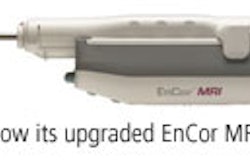VIENNA - Practices looking to augment their bottom line in a time of declining reimbursements for diagnostic imaging may want to cast a long, lingering look at the aesthetic procedure market. According to Dr. Ziv Haskal, a professor of radiology and surgery at the Columbia University College of Physicians and Surgeons in New York City, the U.S. appetite for cosmetic procedures is voracious.
"There was a 444% increase between 1997 and 2005 in all cosmetic procedures performed in the U.S.," he said in a presentation this week at the European Congress of Radiology (ECR). "Within this time, the rise in nonsurgical cosmetic procedures soared by 728%."
Professional groups with interventional radiology talent on board may initially balk at the idea of setting up an aesthetic service line; but with reduced revenues from more traditional inventory models in the current fiscal reality, it may well be worthwhile to at least generate a cosmetic medicine pro forma statement for a practice's catchment area.
"As the New York Times noted, 'The business of beauty is big,'" Haskal said. "We treat patients with varicose veins because their legs are aching and also because they may be unsightly. And as you treat them, these patients ask for other cosmetic interventions, such as collagen fillers, Botox injections, or maybe variations on liposuctions."
He reported that a one-day symposium on cosmetic procedures that he chaired at the 2007 Society of Interventional Radiology (SIR) conference in Seattle last month had more than 350 attendees for the 10-hour session.
"We already know how to make our patients feel good," Haskal said. "Now we can also learn how to make them look good."
He observed that interventional radiologists arguably have the finest skill set in medicine when it comes to performing minimally invasive procedures, and he is optimistic that these specialists can quickly see their talents blossom in the cosmetic procedure market space.
"Ten years ago I never would have imagined that I would be doing fibroid embolizations," Haskal said. "In the same way that we perhaps wouldn't have imagined doing endovenous ablation and sclerotherapy, we need to keep looking toward the next things that we may go on to."
According to Dr. Andy Adam, a professor of interventional radiology at Kings College, London, clinical colleagues from other medical disciplines may express surprise when they discover the specialty's entry into the cosmetic procedure market.
"Of course, we are used to interacting with vascular surgeons, so our interest in treating varicose veins will only further stimulate that pleasant interaction," he drolly noted in a presentation at the ECR. "But dermatologists and plastic surgeons might choke over their porridge when they hear the terms interventional radiology and cosmetic medicine being linked."
For those practices not yet comfortable with bringing wrinkle, spider vein, and sun spot service lines to their product inventory, adding a varicose vein removal clinic to the procedure mix could be a profitable first step into the cosmetic medicine arena.
According to Dr. Sanjoy Kundu, medical director of the Vein Institute of Toronto, approximately 25% of all women and 15% of all men in North America have some kind of lower extremity venous insufficiency.
"The end result of venous insufficiency is varicose veins, spider veins, and skin changes of varying severity depending on the severity and chronicity of venous reflux," he said in a presentation at the ECR.
In the past, patients with varicose veins were referred for surgical stripping, but this invasive procedure is no longer the gold standard of treatment, Kundu noted. Endothermal treatment under ultrasound guidance, using radiofrequency ablation (RFA) or laser technology, has become the procedure of choice, he said.
Although outpatient settings for the minimally invasive treatment of varicose veins looks to be a solid place to gain a foothold in the cosmetic medicine market, an appropriate ambience is critical to ensuring the success of such a venture. The design of a traditional diagnostic imaging facility is simply not a welcoming environment for patients concerned with cosmetic appearance.
"You have to have an attractive, welcoming situation -- what we describe as a 'bright, brass, and glass' setting," Kundu said. "You have to have furniture and the decor that fits the cosmetic environment."
According to Haskal, interventional radiology has been a field that has been marked by several evolutionary and revolutionary stages. Although its practice has been under siege and incursion in the U.S. by vascular surgeons, cardiologists, nephrologists, and oncologists, Haskal sees a brighter future for the specialty.
"It's not the strongest of the species that survive, or the most intelligent, but the ones most responsive to change," he said, citing Charles Darwin.
By Jonathan S. Batchelor
AuntMinnie.com staff writer
March 13, 2007
Related Reading
DRA's arrival forces imaging centers to adapt, February 1, 2007
Competitive strategy can carve out collaborative interventional turf, September 12, 2006
MR-guided intervention takes off in Japan, June 29, 2006
Interventional radiologists guide foam into veins for pain relief, March 31, 2006
Interventional radiology needs rebranding, revitalizing, March 7, 2006
Copyright © 2007 AuntMinnie.com



















